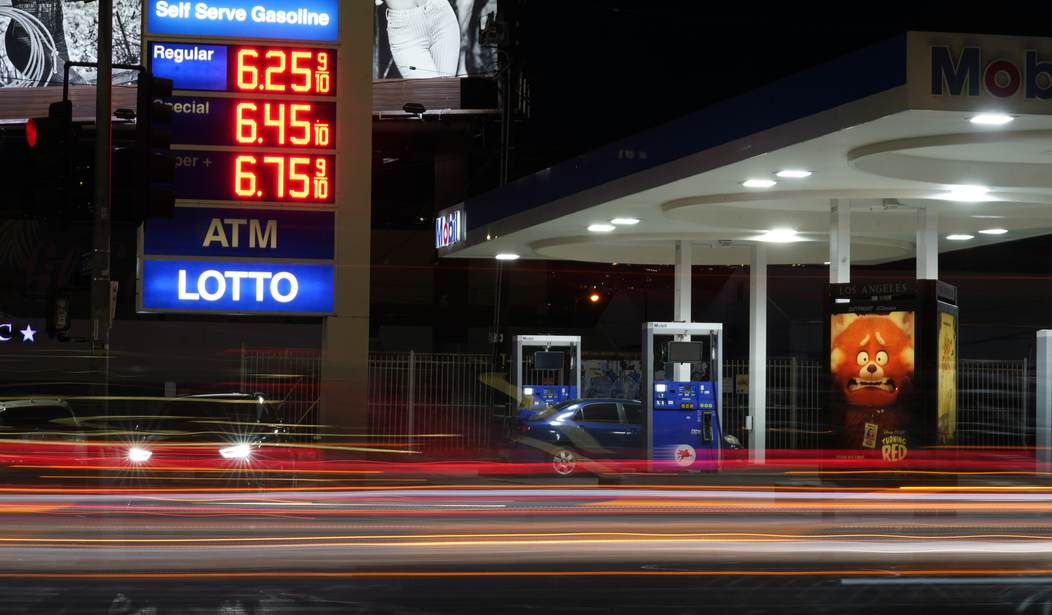Consider this a momentary reprieve rather than a real turnaround. Gas prices dropped unexpectedly in the run-up to the July 4 holiday weekend, the Wall Street Journal notes, but not because of a large amount of fresh supply coming onto the market. Instead, demand finally dropped as consumers changed plans — and there’s no reason to think that the supply issues will improve as the summer wears on:
The average cost of a gallon of unleaded gas was $4.75 Thursday. That’s down about 5% since prices hit their highest point, $5.02, on June 14, according to data from OPIS, an energy-data and analytics provider.
The drop is primarily due to diminished demand at the pump, according to a AAA report released this week. An increased supply of gas and lower oil prices have also contributed to the recent price drop, AAA said. Crude oil futures were at about $102 a barrel Thursday evening, down about 16% in the past month.
Gasoline sales leading up to Independence Day trailed previous years. Same-store gasoline demand by volume fell about 7% for the week ending July 2, compared with the same period last year, according to OPIS data. Demand that week was down about 13% compared with the same period in 2019. In mid-to-late May, gasoline demand fell to its lowest levels in nearly a decade, according to government data.
Gas prices may continue to fall if the trends continue, the AAA report said. However, “July is typically the heaviest month for demand as more Americans hit the road, so this trend of easing prices could be short-lived,” AAA spokesman Andrew Gross said in a statement.
It’s not actually an unprecedented decline. Even in the current sharp incline in gas prices that started shortly after Joe Biden took office, we have seen similar and momentary drops in price. The last such extended period took place in April, as this chart of EIA data reminds us:

In April, the momentary decline came after a sudden acceleration in the rate of increase, and lasted until the supply-demand balance more or less hit the previous trajectory. That may be the case here too as people prepared for summer vacation with more demand, which then got doused by the price signals that created. The upward inflection off of the 2022 trajectory looks smaller than it did in March, which may indicate that the drop will be shallower and shorter this time, too.
One point that may extend it, however, is a recent drop in crude oil prices pushed by worry in the futures markets about recession. It has yet to arrive but seems all but unavoidable in the US and other markets where central bankers have to conduct extraordinary interventions to tamp down inflation. Right now refinery output and capacity may have more to do with the volatility of gas prices, but crude futures are the ultimate basis for the price at the pump. Even the falloff this week was short-lived, however:
After crude hit a three-month low, oil prices rebounded sharply Thursday with benchmark US crude climbing back above $100 per barrel.
West Texas Intermediate prices jumped nearly 5% to $103.27. Brent crude, the international benchmark, surged over 4% to about $104.92 after it had moved as low as $98.50 earlier.
Both benchmark crude prices closed Wednesday at their lowest points since April 11 as recession fears weighed on the outlook for demand.
As of close of business yesterday, overall oil prices were $104.80 and Brent hit just over $107 a barrel. The rebound of those prices likely had something to do with the jobs report in the US showing a consistently large growth in recovered jobs, which indicates that businesses see enough room for growth this year. That signals a higher demand, which keeps crude oil prices high without any additional supply in sight. And that means more price increases at the pump for this summer, especially given the limitations of refining in the US.
So enjoy the brief respite at the pumps while it lasts, because it likely won’t last long. Even if it does, it will be from a continuing falloff of demand in the summer, which would mainly result from a decline in consumer spending on vacations. That will be bad news for other parts of the economy, not to mention the emotional health of American households.
And in case you’re wondering, don’t expect the gas price decline to do much about the inflation situation. Gas prices are a force multiplier for inflation, but the most recent EIA average price is only 4.5% lower than the peak three weeks ago, and it’s still 10.5% higher than the mid-March peak in the previous mini-bubble. For that matter, the price in the first week of July is only 2% lower than it was in the first week of June, and it’s still 51.7% higher than it was in the first week of July a year ago. Besides, most goods move by diesel, and the EIA’s average diesel price is only 0.4% lower than at the beginning of June, 3% more than at the beginning of May, and 70.3% higher than at the beginning of July 2021. Inflation will keep on trucking, unfortunately.









Join the conversation as a VIP Member